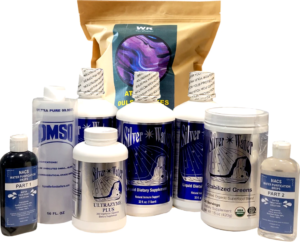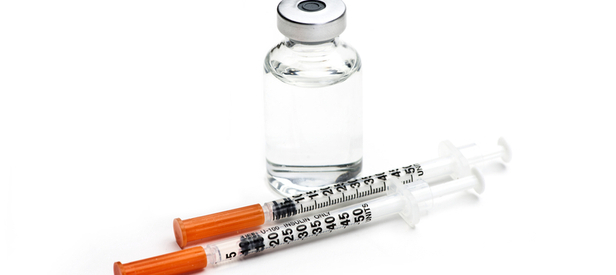The secret to eliminating diabetes is to have a better understanding of it beyond that which might be conveyed by modern medicine. Armed with an open mind and the ability to conduct research and expand your knowledge base, you can put yourself in the driver’s seat and empower yourself to proactively handle the issue on your own if you choose to do so.
What Do “They” Say About Diabetes?
There are two types of diabetes: type 1 and type 2 diabetes.
Type 1 Diabetes
Type 1 diabetes is caused by an autoimmune condition in which the immune system mistakenly attacks and destroys the pancreas’s insulin-producing cells (beta cells). Although the exact cause of diabetes type 1 isn’t fully understood, genetic and environmental factors are proposed to play a role.
Symptoms of type 1 diabetes include
-
- Rapid onset (symptoms appear quickly, often within days or weeks)
- Increased thirst
- Frequent urination
- Unexplained weight loss
- Presence of ketones in urine (a byproduct of muscle and fat breakdown due to insufficient insulin)
Early warning indicators that you might be turning into a type 1 diabetic include symptoms (above) appearing at an early age in children, especially frequent urination and constant thirst.
Type 2 Diabetes
Type 2 diabetes is caused by insulin resistance (cells don’t respond well to insulin) and impaired insulin production. Risk factors include genetics, obesity, sedentary lifestyle, and age.
Symptoms of type 2 diabetes include
-
- Develops gradually over time
- Increased thirst
- Frequent urination
- Increased hunger
- Unintended weight loss
- Fatigue
- Blurred vision
- Slow-healing sores
- Frequent infections
Early warning indicators that you might be turning into a type 2 diabetic include increased hunger, fatigue, frequent infections, slow-healing sores, and other symptoms mentioned above.
What To Do If You Think You Might Have or Be Developing Diabetes
They say if you think you have diabetes, consult a doctor as soon as possible because if you get an early diagnosis, your outcomes will be much better.
What to Expect from Your Doctor
Your doctor will conduct the diagnosis and guide you through the maintenance process.
Type 1 Diabetes
You may be introduced to a diabetes care team that includes a nutritionist or dietitian.
You will be expected to learn to count carbohydrates, monitor blood sugar, and understand insulin.
Type 2 Diabetes
You will be warned that major shifts in lifestyle are vastly important, including
-
- Healthy eating
- Regular exercise
- Weight management
- Medications (like metformin) may be prescribed if needed
- Blood sugar monitoring will help you maintain healthy levels.
Expect ongoing follow-up with your healthcare team.
How They Will Help You Manage Your Diabetes Over Time
You will be expected to make the following lifestyle changes over time:
-
- Establish a Healthy Diet
- Balanced meals
- Portion control, and
- Carbohydrate awareness
- Exercise Regularly
- Physical activity helps regulate blood sugar
- Weight Management
- Maintain a healthy weight
Medications
-
- Metformin is commonly prescribed for type 2 diabetes.
- Other medications may be added as needed.
Blood Sugar Monitoring
-
- Regular checks empower you to make informed decisions.
Diabetes Education
-
- Certified Diabetes Education Specialists guide you on insulin use, lifestyle adjustments, and self-management.
You can see that they have set up a tremendous amount of support with numerous professionals involved in the management of your diabetes, which professionals deem to be an incurable but manageable disease.

What Wayne Rowland Says About Diabetes
Suppose you are interested in learning something besides what you might hear from your doctor, who was trained by a system put in place by the people behind the pharmaceutical complex. In that case, you will have to become curious and start looking for clues outside the box of conventional medicine.
Defeating Diabetes Eating Sugar and Rice
For instance, we believe that diabetes is largely about sugar and that sugar is the enemy of diabetics. Yet, in 1942, Duke University’s Doctor Walter Kempner became renowned for reversing diabetes by placing patients on his Sugar and Rice Diet. That’s right; regular table sugar is used to wipe out diabetes. This causes one to pause and think about what we know about diabetes.
To get a more grand overview of diabetes, let’s go back in time.
How were doctors treating diabetes before the introduction of insulin-based therapies?
Early Treatments for Diabetes Before the Advent of Insulin Therapy (1800s to Early 1900s)
Diabetes, known for its hallmark symptom of excessive urination, has been a recognized disease for thousands of years. Before the advent of insulin therapy in the 1920s, various methods were employed to manage diabetes, with varying degrees of success.
Early Dietary Treatments
One of the earliest approaches to managing diabetes was through dietary modifications. Doctors in the 19th century began recognizing the link between diet and blood sugar levels. Dr. Frederick William Pavy and Dr. John Rollo were prominent figures in this period.
Dr. Frederick William Pavy: In the mid-1800s, Pavy, a British physician, advocated for a low-carbohydrate diet to manage diabetes. He believed that carbohydrates were the primary source of glucose in the blood and recommended reducing their intake to control blood sugar levels.
Dr. John Rollo: Another significant contributor, Dr. John Rollo, a Scottish military surgeon, proposed a high-fat, high-protein diet for diabetic patients in the late 1700s and early 1800s. Rollo’s Meat Diet included meats and fats while avoiding sugar and starches, aimed to reduce glycosuria (the presence of glucose in the urine).
Opotherapy and Organ Extracts
In the late 19th and early 20th centuries, the concept of opotherapy (treatment using animal organ extracts) gained traction. Doctors believed that extracts from healthy organs could replace deficient hormones or enzymes in patients with various conditions, including diabetes.
Dr. George Murray: Murray’s work in the 1890s with thyroid extracts for hypothyroidism inspired similar approaches for diabetes. Researchers began experimenting with pancreatic extracts, hypothesizing that the pancreas produced a substance (later identified as insulin) that regulated blood sugar.
Dr. Oskar Minkowski and Dr. Joseph von Mering: In 1889, these German researchers discovered the link between the pancreas and diabetes. They removed the pancreas from dogs, which subsequently developed diabetes. This pivotal experiment suggested that the pancreas produced a critical substance for glucose metabolism, although the exact nature of this substance remained unknown at the time.
Fasting and Caloric Restriction
Another method employed in the early 20th century was fasting and caloric restriction. This approach aimed to reduce the intake of all food to lower blood sugar levels.
Dr. Frederick Allen: An American physician, Allen pioneered the “starvation diet” in the 1910s. He believed that severe caloric restriction could prolong the lives of diabetic patients by preventing the acute complications of hyperglycemia. Patients under Allen’s care were subjected to extremely low-calorie diets, sometimes as little as 400-600 calories per day.
Alkali Therapy
In the early 20th century, some physicians experimented with alkali therapy to manage diabetes, based on the belief that diabetes was related to an imbalance in body chemistry.
Dr. Joseph von Mering: Building on his earlier work with Minkowski, von Mering also explored the use of sodium bicarbonate to neutralize the acidic by-products of fat metabolism in diabetic patients. This treatment aimed to counteract diabetic ketoacidosis, a severe complication of uncontrolled diabetes.

What Does Wayne Rowland Say About Diabetes?
It doesn’t really matter what the learned medical and scientific communities assert about diabetes. The truth is this: anyone who conducts my Disease Symptom Elimination Program and drinks 10 cases of my B-flat infused Tesla-lightning Silver Water will no longer experience symptoms.
The Hidden Cause of Diabetes: Worms
What most people don’t realize is that the pancreatic source of diabetes is due to worms. Yes, all kinds of worms, even those incompatible with human physiology, are setting up camp inside your pancreas. Normally, these microscopic eggs would pass through the human body unhatched. However, these entities can now hatch, breed, and infest your body thanks to modern food production processes.
How Parasitic Worms Get Inside Us
In food production, alcohol is used to clean equipment between product runs. It effectively removes substances related to the previous batch and sanitizes the equipment’s surface areas. This process is commendable, but there’s a weak link in the rinsing. If the rinsing process is rushed to save production time, residual alcohol may remain on the equipment for the next run. This residual alcohol becomes part of the food supply, an unlisted ingredient in what you eat.
What Happens Inside Our Bodies
Your body recognizes that this ingredient is not fit for human consumption and reroutes it to your pancreas to protect your body from any ill effects—a natural defense mechanism. Normally, unhatched parasite and worm eggs that are not matched for human physiology remain in a state of suspended animation and simply pass through until they find a suitable host.
Our Body’s Defense System
The human body is truly amazing, equipped with a defense mechanism to protect us from pathogens. In a healthy immune system, our T cells chase down these parasitic invaders, wiping them out or moving them into the excretory system. The problem arises when parasites possess equally amazing survival skills, flee T cell attacks, and find refuge in the pancreas where T cells are absent. Not only is this a safe haven for parasites, but the alcohol stored in the pancreas breaks down the protective shell of the foreign eggs, allowing them to hatch, propagate, and thrive.
Diabetes is a Choice
This is the cause of diabetes and many other diseases. When you conduct a comprehensive parasite cleanse and deworming procedure, breaking down the biofilm where parasites, including pathogenic spirochetes, find refuge, they have nowhere to hide or run. Over a relentless 90-day cleansing and deworming period, they are gone.
When they are gone, so is the diabetes. The same is true for many, if not all, disease symptoms. However, this is not a one-time fix for diabetes because you cannot eliminate all parasites if you breathe the air, drink the water, and eat the food you are exposed to daily. Constant exposure to pathogens continues to poison and toxify our bodies.
A one-month parasite cleanse and deworming program conducted once a year as regular maintenance will keep their populations reduced to a manageable level, allowing you to go on about your healthy life.
Through my journey and discovery, I have found that maintaining a healthy lifestyle and regular cleansing can significantly improve your health and eliminate the symptoms of many diseases, including diabetes. Let’s take control of our health and live the vibrant lives we deserve.
Don’t believe me. Keep an open mind. Do your research and come to your own conclusions.
My programs are safe and effective, and they work.
Now that you know, diabetes is a choice.
References
Rosati, R., & Rosati, K. (2006). Kempner’s Rice Diet: The Simple, Scientifically Proven Way to Lose Weight and Reverse Disease. Rodale Books.
Kempner, W. (1944). Treatment of Kidney Disease and Hypertension. Medical Clinics of North America, 28(3), 874-894.
Bliss, M. (2007). The Discovery of Insulin. University of Chicago Press.
Tattersall, R. B. (2009). Diabetes: The Biography. Oxford University Press.
Feudtner, C. (2003). Bittersweet: Diabetes, Insulin, and the Transformation of Illness. University of North Carolina Press.
Pavy, F. W. (1874). A Treatise on the Function of Digestion; Its Disorders and Their Treatment. J. & A. Churchill.
Rollo, J. (1798). An Account of Two Cases of Diabetes Mellitus. C. Dilly.
Foreyt, W. J. (2001) Veterinary Parasitology: Reference Manual Wiley-Blackwell; 5th edition.
Rowland, W (2014). Worms Are Killing You!. Leading Edge University.


Leave a Reply